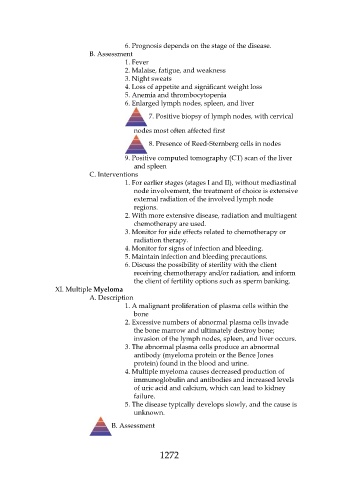Page 1272 - Saunders Comprehensive Review For NCLEX-RN
P. 1272
6. Prognosis depends on the stage of the disease.
B. Assessment
1. Fever
2. Malaise, fatigue, and weakness
3. Night sweats
4. Loss of appetite and significant weight loss
5. Anemia and thrombocytopenia
6. Enlarged lymph nodes, spleen, and liver
7. Positive biopsy of lymph nodes, with cervical
nodes most often affected first
8. Presence of Reed-Sternberg cells in nodes
9. Positive computed tomography (CT) scan of the liver
and spleen
C. Interventions
1. For earlier stages (stages I and II), without mediastinal
node involvement, the treatment of choice is extensive
external radiation of the involved lymph node
regions.
2. With more extensive disease, radiation and multiagent
chemotherapy are used.
3. Monitor for side effects related to chemotherapy or
radiation therapy.
4. Monitor for signs of infection and bleeding.
5. Maintain infection and bleeding precautions.
6. Discuss the possibility of sterility with the client
receiving chemotherapy and/or radiation, and inform
the client of fertility options such as sperm banking.
XI. Multiple Myeloma
A. Description
1. A malignant proliferation of plasma cells within the
bone
2. Excessive numbers of abnormal plasma cells invade
the bone marrow and ultimately destroy bone;
invasion of the lymph nodes, spleen, and liver occurs.
3. The abnormal plasma cells produce an abnormal
antibody (myeloma protein or the Bence Jones
protein) found in the blood and urine.
4. Multiple myeloma causes decreased production of
immunoglobulin and antibodies and increased levels
of uric acid and calcium, which can lead to kidney
failure.
5. The disease typically develops slowly, and the cause is
unknown.
B. Assessment
1272

